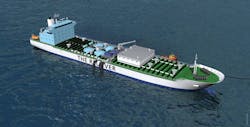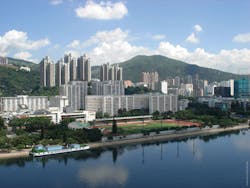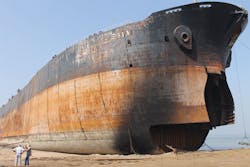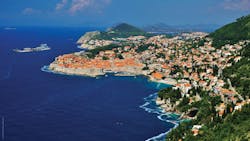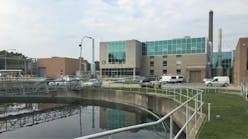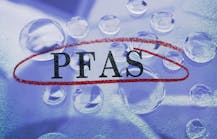Norway's Floating Retrofitted Oil & Gas Tankers
Norwegian company EnviroNor is currently developing an innovative system that uses old oil or gas tankers as mobile wastewater treatment units. So, how exactly does the system work? What are the key technological and operational challenges involved in establishing a project of this type? And what are the potential markets and applications?
Andrew Williams reports
The proposed system works by converting a used oil, gas or other product tanker into a treatment plant by fitting it with the necessary equipment, including filters and piping, and making structural modifications to tank spaces. Primary wastewater treatment is carried out through a standard filtration method, which is followed by biological treatment to remove organic substrate and nitrification using moving bed biofilm reactors (MBBR) in two parallel lines. The basic process can also include coagulation, floatation and sludge treatment, as well as biogas extraction.
"In addition to the ‘normal' process equipment such as pumps, screens and membranes, we utilise subsea technology from the oil and gas industry, and we take advantage of the vessel configuration whereby we can us existing tanks for process tanks and we can also utilise some of the energy resources they have onboard a vessel," says Sigmund Larsen, founder & general manager at EnviroNor.
If wastewater is designated for reuse for industrial purposes or irrigation, additional treatment will also include fine filtration and UV disinfection. In terms of infrastructure, Larsen explains that the unit requires "an existing onshore wastewater infrastructure to which it can be connected". The chosen location must also possess sufficient sea depth, and the vessel needs to be anchored in a sheltered area "to ensure an optimal treatment process".
For Larsen, a key advantage of the proposed system is that it is a ‘flexible solution' for recycling wastewater offshore that is based on proven technology, "but applied onboard a ship or a floating unit". The system is also flexible in terms of size, and Larsen reveals that it could be designed in response to the specific requirements at a particular location. One planned example uses a phased-out product tanker as a platform, but he says that "several other types of ships as well as barges and dedicated floating units may also fit the purpose".
Inspiration
As Larsen explains, the idea for the system came to him during a trip to Dubai, where he saw used Dubai municipality tanker lorries transporting wastewater from the residential area into a wastewater treatment plant about 30km away in the desert.
"Apparently there are between 6000-8000 trucks transporting wastewater daily. While we were in Dubai some of the truck drivers made a ‘short cut' and discharged the wastewater into the sea. From the populous areas to the sea there are only a few hundred meters, hence they saved a lot of time," he says. "What the truck drivers did not realise was that the sewage was washed back to the beaches, which resulted in complaints from the tourists. It was then I conceived the idea to put a wastewater treatment plant onboard on a ship," he adds.
Larsen, who has worked his entire life in the shipping industry, stresses that the demolition of vessels is a key challenge - and he describes a tanker vessel as being like ‘a bottle of milk' because it "can't be used after a certain date, normally 30 years". However, he also reveals that it is quite common for a vessel to be demolished well before the 30 year mark for a variety of reasons, ranging from customer requirements and port rules to vessel energy efficiency and market conditions.
"If there is an excess of vessels in the marked then the demolition age tends to go down, there are cases where vessels have been demolished when they are 14 years old. To demolish a vessel represents an environmental challenge for a ship owner, many owners demolish vessels in countries where labour and environmental issues are not taken too seriously. Hence, this reduces their brand value," he adds.
Key Benefits
In Larsen's view, the process itself is "no different to the process on an onshore treatment plant". He reveals that the system is capable of treating wastewater to a level where it is safe to discharge into the environment or treating it "all the way", so that it can be reused as water for industrial or irrigation purposes, and "even up to potable water standard".
For him, a floating system such as this "brings new solutions into the water industry", particularly in large cities, which he says often run short of enough land area for these kinds of process plants.
Financially speaking, he also points out that it costs less money to recycle wastewater than it does to desalinate seawater, and potential investors face much lower upfront costs, while also retaining control over the asset.
In technical terms, he also cites the short timeframe "from decision to operationalization" as a key benefit, as well as the fact it is "easy to upgrade to new technology and capacity". In the event of political instability, he also highlights the fact that it is simple to "decommission the asset".
"The time from the decision to build a wastewater treatment plant onshore [to completion] usually takes seven to 10 years. To build the same plant on a converted vessel takes two to three years. Probably closer to two years than three - the reason being an offshore plant does not need all the building permissions. However, an offshore plant would require permission from the port authorities and environmental authorities," he says.
"The fact that DNV GL has verified the concept both technically and economically means we don't see any major technical or economic challenges. However, we do acknowledge there might be political and mental challenges. The politicians and bureaucrats tend to think inside the box rather than outside the box. The EnviroNor concept represents a paradigm change to the water industry," he adds.
However, Larsen is also keen to point out that similar offshore systems, called Floating Storage and Regasification Units (FSRU), are currently being used in the LNG industry, as well as in the oil and gas industry where they use Floating Production, Storage and Offloading (FPSO) systems.
"Hence, this will hopefully give the politicians and bureaucrats sufficient comfort that it can also be used in the water industry. The global water challenges will not be solved unless somebody has the courage to think differently," says Larsen.
"Floating wastewater treatment systems will be financed differently and against a long-term operation contract," he adds.
Industry Opinion
Keith Hays, managing director - EMEA at Bluefield Research, agrees that such a system would have a number of clear advantages, primarily based on its mobility and portability.
He says this would make it a "useful feature for specific applications requiring flexible capacity" such as during emergencies or to service "seasonal needs". He also believes that the reduced CAPEX costs achieved by using "depreciated infrastructure" and the ease of setup and permitting could also make the system an interesting alternative.
On the flipside, he highlights a number of possible disadvantages, including the limited geographical scope, and the fact that it is "not site specific" meaning that there may be "potential challenges with feed water quality". In technological and operational terms, he also believes that the system may face additional challenges in dealing with boat traffic and opposition from environmental groups, as well as in securing adequate pipe connections from the water and wastewater sources.
"Designing a plant that is specific enough for key applications that benefit from mobility, but not so specific that the plant cannot be used at a different site [will be a challenge]," he adds.
Market Applications
Although EnviroNor has not yet established a working system, Larsen reports that the company is currently working with three interested clients in different countries - and "if all goes well" he expects to "start the feasibility study shortly".
He adds: "We are working with three possible locations. After we sign a Letter of Intent (LOI) with the customer then we will commence with the feasibility study. We have split up the feasibility study into two parts - a high level that will end up with a simple ‘yes or no' result and a second detailed study that includes all aspects of the projects."
Larsen reveals that there are currently four unique ‘solutions' based on the concept - each with different markets, "from the developed world to areas in the underdeveloped world". The system is also flexible enough to mix and match between these basic systems and, although he says that the market is "obviously limited" to coastal and river areas.
In terms of future potential markets, Hays believes that the system would be best suited for disaster relief and military applications - as well as for the "temporary substitution of land based plants". As far as possible regional markets go, he points out that the system could be very useful for disaster relief in South East Asia and could be applied in the African petrochemical industry.
"This will probably be a niche solution that will focus on a set of segments valuing rapid siting, mobility, and the economics it can deliver," Hays concludes.
Andrew Williamsis a freelance correspondent for WWi magazine. For more information, email: [email protected]
